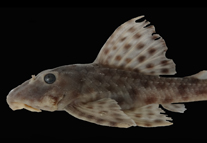Abstract
Based on a single male specimen, a remarkable new species of the genus Navicordulia is described from the Massif du Mitaraka in French Guiana (Tumuc-Humac Mountains). Another new species of this genus is also reported from the same locality but is not described. This is the first record of the genus from French Guiana, hitherto being unknown within a radius of more than 1000 km. Apparent rarity or absence of records is probably due to its secretive habits. Navicordulia tumucurakensis sp. nov. presents unique characters not present in other species of the genus including: almost no excavation of the anal angle, proximal sternal pilose ridge of abdominal segment 7 transformed into two large lateral oreillets disconnected from the median carina, additional distal sternal pilose ridge transformed into a medial knob, epiproct not extending beyond the distal half of the cerci, very long cerci surpassing those of described species, cerci lacking ventro-medial carina and tubercle and exhibiting a distal ventral brush of hair-like setae. It is a forest species inhabiting hilly landscapes at low altitude, unlike other closely related intertropical species which are encountered in more elevated areas above 850 m. It is most closely related to N. longistyla, a typical cerrado species from the central Brazilian plateau or possibly to N. nitens from the central south Venezuelan Guaiquinima Tepui. Based on unique derived male abdominal structures and also on the female ovipositor and related structures, the South American genus Navicordulia and the Southeast Asian/Melanesian genus Metaphya are considered current adelphotaxa. This disrupted geographic distribution could be explained by a common ancestor having had a Gondwanian dispersal until the Late Cretaceous or Paleocene.References
Bechly, G. (1996) Morphologische Untersuchungen am Flügelgeäder der rezenten Libellen und deren Stammgruppenvertreter (Insecta; Pterygota; Odonata), unter besonderer Berücksichtigung der Phylogenetischen Systematik und des Grundplanes der Odonata. Petalura, Special Volume, 2, 1–402.
Calvert, P.P. (1909) Contributions to a knowledge of the Odonata of the Neotropical Region exclusive of Mexico and Central America. Annals of the Carnegie Museum, 6 (3), 73−280.
Davies, D.A.L. (2002) The odonate fauna of New Caledonia, including the descriptions of a new species and a new subspecies. Odonatologica, 31 (3), 229−251.
De Marmels, J. (1989) Odonata or dragonflies from Cerro de la Neblina and the adjacent lowland between the Rio Baria, the Casiquiare and the Rio Negro (Venezuela). I. Adults. Boletín de la Academia de las Ciências Físicas, Matemática y Naturales, 25, 11−78.
De Marmels, J. (1991) Dorocordulia nitens sp. n., eine neue Smaragdlibelle aus Venezuela (Odonata: Corduliidae). Mitteilungen der Entomologischen Gesellschaft Basel, 41, 106−111.
Fleck, G. (2004) La larve du genre Cyanothemis Ris, 1915 (Odonata: Anisoptera: Libellulidae). Conséquences phylogénétiques. Annales de la Société Entomologique de France, New Series, 40, 51–58.
Fleck, G. (2007) Contribution à la connaissance des Odonates de Nouvelle Calédonie. La larve du genre Metaphya Laidlaw, 1912 (Anisoptera, Corduliidae). Bulletin de la Société Entomologique de France, 112 (2), 183–186.
Fleck, G. (2012) Preliminary notes on the genus Aeschnosoma Selys, 1870 (Odonata: Anisoptera: Corduliidae s.s.). Annales de la Société Entomologique de France, 48 (1–2), 225–228.
https://doi.org/10.1080/00379271.2012.10697766Fleck, G. & Neiss, U.G. (2012) A new species of the genus Aeschnosoma Selys, 1871 (Odonata: Anisoptera: Corduliidae s.s.). Zootaxa, 3159, 47–58.
Fleck, G. & Legrand, J. (2013) Notes on the genus Libellulosoma Martin, 1906, and related genera (Odonata: Anisoptera: Corduliidae). Zootaxa, 3745 (5), 579–586.
https://doi.org/10.11646/zootaxa.3745.5.6Fleck, G., Brenk, M. & Misof, B. (2008) Larval and molecular characters help to solve phylogenetic puzzles in the highly diverse family Libellulidae (Insecta: Odonata: Anisoptera): The Tetrathemistinae are a polyphyletic group. Organisms Diversity and Evolution, 8 (1), 1–16.
https://doi.org/10.1016/j.ode.2006.08.003Marcel, G. (1898) L'apparition cartographique des monts Tumuc-Humac. Journal de la Société des Américanistes, 2, 14–24.
https://doi.org/10.3406/jsa.1898.3310Garrison, R.W., von Ellenrieder, N. & Louton, J.A. (2006) Dragonfly genera of the New World: an illustrated and annotated key to the Anisoptera. The John Hopkins University Press, Baltimore, xiv + 368 pp.
Geijskes, D.C. (1970) Generic characters of the South American Corduliidae, with descriptions of the species found in the Guyanas. Studies on the Fauna of Suriname and other Guyanas, 44, 1–42.
Machado, A.B.M. & Costa, J.M. (1995) Navicordulia gen. nov., a new genus of neotropical Corduliinae, with descriptions of seven new species (Anisoptera: Corduliidae). Odonatologica, 24 (2), 187–218.
Pfau, H.K. (1991) Contribution of functional morphology to the phylogenetic systematics of Odonata. Advances in Odonatology, 5, 109–141.
Pfau, H.K. (2011) Functional Morphology and Evolution of the Male Secondary Copulatory Apparatus of the Anisoptera (Insecta: Odonata). Zoologica, 156, 1–103
Pinto, A.P. & Lamas, C.J.E. (2010) Navicordulia aemulatrix sp. nov. (Odonata: Corduliidae) from northeastern Santa Catarina State, Brazil. Revista Brasileira de Entomologia, 54 (4), 608–617.
https://doi.org/10.1590/S0085-56262010000400012Pinto, A.P. & Lamas, C.J.E. (2011) Description of the female of Navicordulia aemulatrix Pinto & Lamas and additional notes on the male (Odonata: Corduliidae). Neotropical Entomology, 40 (6), 698–703.
Ris, F. (1911) Libellulinen monographisch bearbeitet. Collections Zoologiques du Baron Edmond de Selys-Longchamps, 12 , 385–700.
Sanmartín, I. & Ronquist, F. (2004) Southern Hemisphere biogeography inferred by event-based models: plant versus animal patterns. Systematic Biology, 53 (2), 216–243.
https://doi.org/10.1080/10635150490423430Santos, N. D. (1968) Notas sobre « Dorocordulia errans » Calvert, 1909 (Odonata, Corduliidae). Atas da Sociedade de Biologia do Rio de Janeiro, 11, 201–202.
Veevers, J.J. (1991) Phanerozoic Australia in the changing configuration of Proto-Pangea through Gondwanaland and Pangea to the present dispersed continents. Australian Systematic Botany, 4, 1–11.
Woodburne, M.O. & Case, J.A. (1996) Dispersal, vicariance, and the Late Cretaceous to Early Tertiary land mammal biogeography from South America to Australia. Journal of Mammalian Evolution, 3, 121–161.
https://doi.org/10.1007/BF01454359

